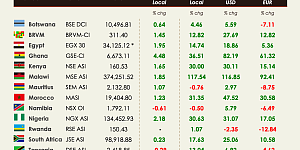One word came to mind to describe African markets this year: rollercoaster. From currency fluctuations, to commodity prices volatility and weaker growth than expected, you name it… Investors have had to tighten their seatbelts more than once only for some to discover that the landing would take more time than anticipated and would require some additional refuelling stops. Yet, from our point of view the investment case for Africa has not really changed. The fundamentals such as the booming demographics are still intact, however clouded by short-term macroeconomic challenges. This calls for a toned look at the individual markets constituting African markets.
Markets like Zambia, Ghana and Nigeria have experienced a freefall this year. The LuSE ASI is the worst performer year-to-date, down 26.83% in local currency. Zambia is facing the slowest growth in decades and a growing budget deficit. The country relies on copper for more than 70% of its export revenue and has therefore suffered from commodity prices plunged which led to weakened currencies and widened budget shortfalls. Foreign exchanges reserves have dropped because of Eurobonds’ interest payments as well as fuel and farm subsidies. Same story in Ghana as illustrated by the resounding vote for change during recent elections. The economy has slowed down due to a fall in global prices for its exports of gold, cocoa and oil. In addition, fiscal deficits soared driven by a ballooning of the wage bill and a too accommodative monetary policy which led to significant increase in inflation and depreciation of the Cedi. The GSE-CI is down 24.55% ytd. The naira devaluation did not seem to be enough to make investors feel comfortable about Nigeria as the country is still battling dollar scarcity, a recession and an increasing budget deficit. The NGSE ASI lost 6.17% this year.
Another highlight this year is the avoidance of South-Africa’s credit rating downgrade despite elevated political tensions throughout the year. Potential consequences were feared as rating changes could have increased borrowing costs and made it tougher for the government to meet its debt obligations, obtain credit and meet fiscal targets. The JSE ASI ended this year flat.
In these challenging times, some strongly performing economies have surfaced in 2016. Kenya, Morocco, Tanzania and Cote d’Ivoire, all oil-importing economies, stood out thanks to fair growth and appropriate policy choices.
This year’s best performer is the EGX 30 gaining 76.20%. The benchmark benefitted from positive sentiment following the long-awaited Egyptian pound floatation and the approval of the $12 billion loan fund facility by the IMF.
Finally, one of the last 2016 surprise was the launch of a new national currency in Zimbabwe to reduce cash shortage. The bond notes have been welcomed by the market judging by the performance of the ZSE Ind. which gained 25.84% this year.
Geographies and sectors matter when investing on African markets. Looking ahead, we see a slight recovery in Nigeria and South Africa. We should also witness some marginal relief in oil exporting countries thanks to better oil prices but this will probably be skewed towards the end of the year. In 2017, we see East-African markets as more inclined to drive sustainable growth and consumers-led sectors as well as infrastructure, power and agriculture to outperform.










































